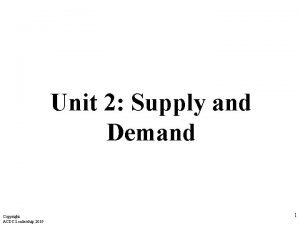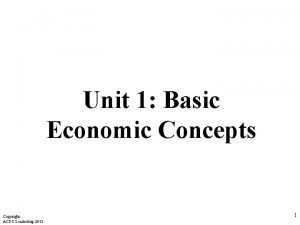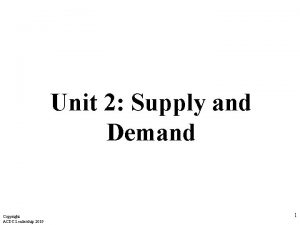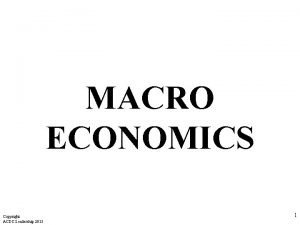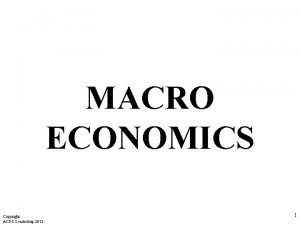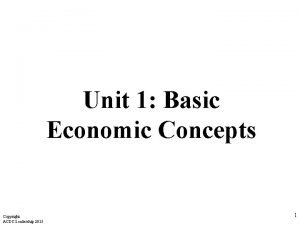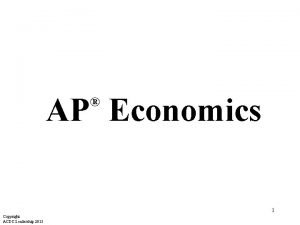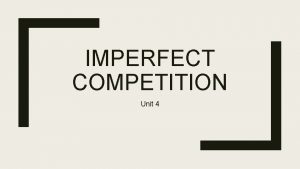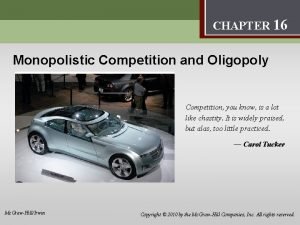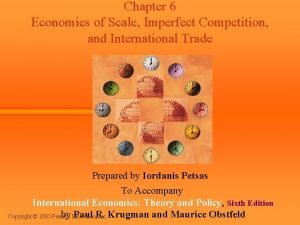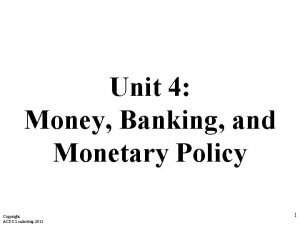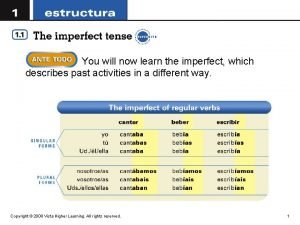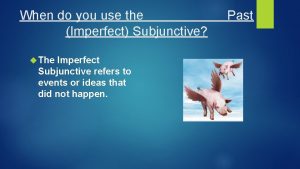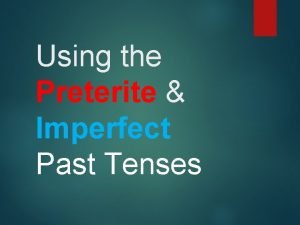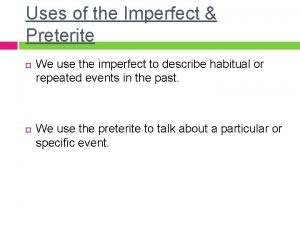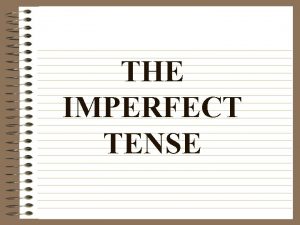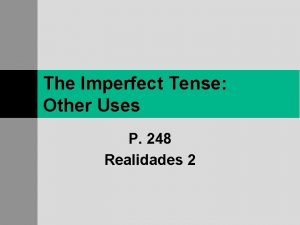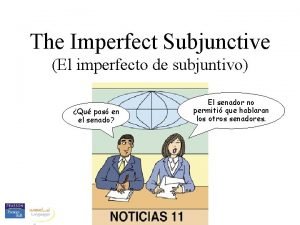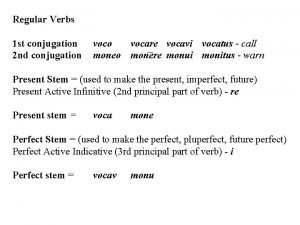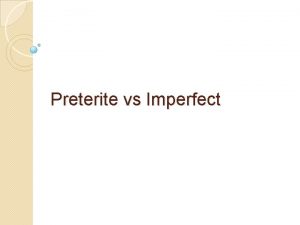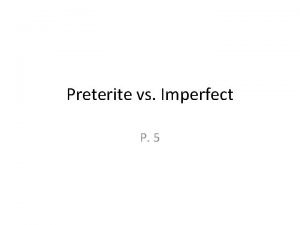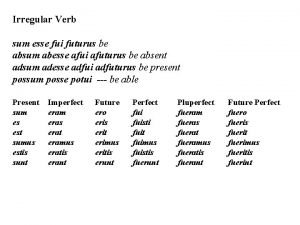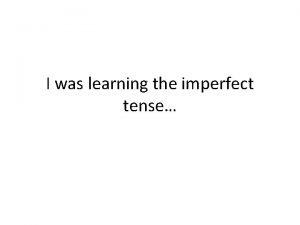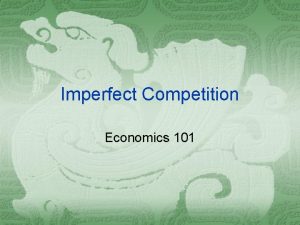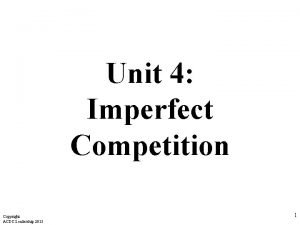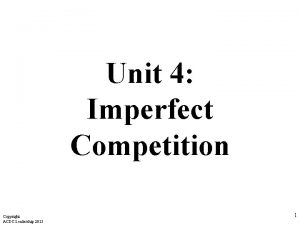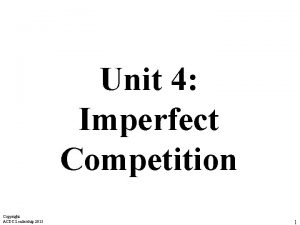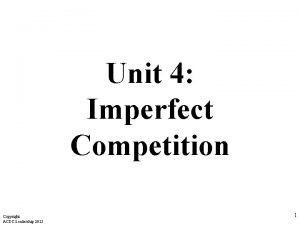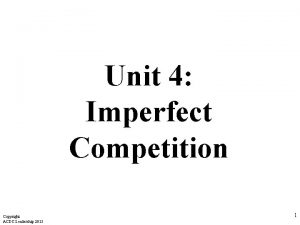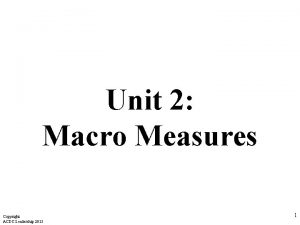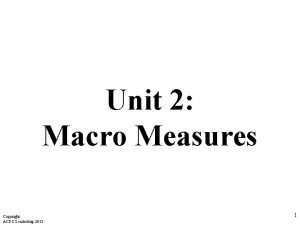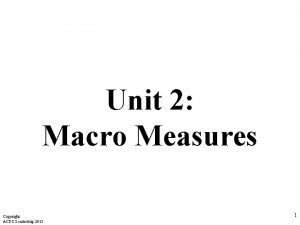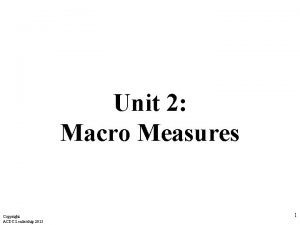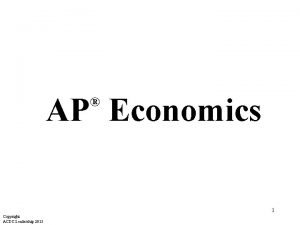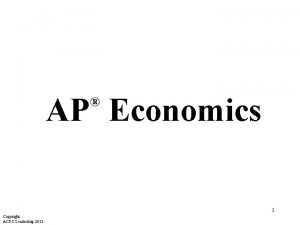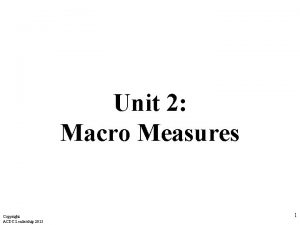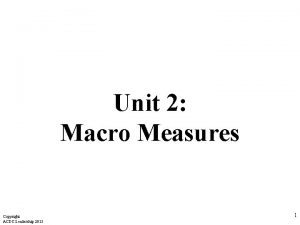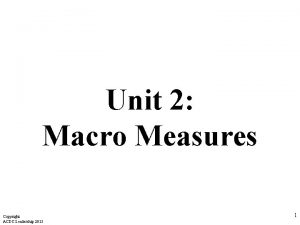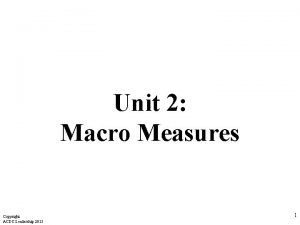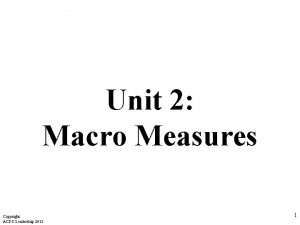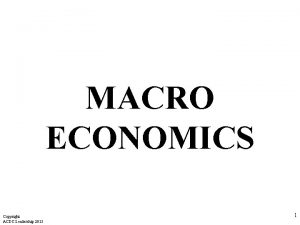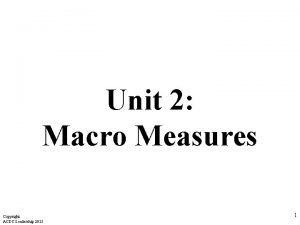Unit 4 Imperfect Competition Copyright ACDC Leadership 2015

























































- Slides: 57

Unit 4: Imperfect Competition Copyright ACDC Leadership 2015 1

Memorizing vs. Learning 2 -35711131 -719232 -9 Try memorizing the above number How effective is memorizing it? The point: If you try to MEMORIZE all the graphs of economics you will forget them. You must LEARN them! Copyright ACDC Leadership 2015

FOUR MARKET STRUCTURES Perfect Competition Monopolistic Competition Oligopoly Pure Monopoly Imperfect Competition Every product is sold in a market that can be considered one of the above market structures. For example: • Fast Food Market • The Market for Cars • Market for Operating Systems (Microsoft) • Strawberry Market • Cereal Market Copyright ACDC Leadership 2015 3

Monopoly Copyright ACDC Leadership 2015 4

Four Market Structures Perfect Competition Monopolistic Competition Oligopoly Monopoly Characteristics of Monopoly: Examples: The Electric Company, De Beers, • One large firm (the firm is the market) • Unique product (no close substitutes) • High Barriers- Firms cannot enter the industry • Monopolies are “Price Makers” • Some advertising Copyright ACDC Leadership 2015 5

What do you already know about monopolies? True or False? 1. All monopolies make a profit. 2. Monopolies are usually efficient. 3. All monopolies are bad for the economy. 4. All monopolies are illegal. 5. Monopolies charge the highest price possible 6. The government never prevents monopolies from forming. Copyright ACDC Leadership 2015 6

Can a monopoly be good for the economy? Ex: Electric Companies • If there were three competing electric companies they would have higher costs. • Having only one electric company keeps prices low Economies of scale make it impractical to have smaller firms. Natural Monopoly- It is NATURAL for only one firm to produce because they can produce at the lowest cost. Copyright ACDC Leadership 2015 7

Drawing Monopolies Copyright ACDC Leadership 2015 8

Good news… 1. Only one graph because the firm IS the industry. 2. The cost curves are the same 3. The MR= MC rule still applies 4. Shut down rule still applies Copyright ACDC Leadership 2015 9

The Main Difference • Monopolies (and all Imperfectly competitive firms) have downward sloping demand curve. • Which means, to sell more a firm must lower its price. • This changes MR… THE MARGINAL REVENUE DOESN’T EQUAL THE PRICE! Copyright ACDC Leadership 2015 10

Why is MR less than Demand? Copyright ACDC Leadership 2015 P Qd TR MR $11 0 0 - 11

Why is MR less than Demand? $10 Copyright ACDC Leadership 2015 P Qd TR MR $11 0 0 $10 10 12

Why is MR less than Demand? $10 $9 Copyright ACDC Leadership 2015 P Qd TR MR $11 0 0 $10 10 $9 2 18 8 $9 13

Why is MR less than Demand? $10 $9 $9 $8 $8 Copyright ACDC Leadership 2015 P Qd TR MR $11 0 0 $10 10 $9 2 18 8 $8 3 24 6 $8 14

Why is MR less than Demand? $10 $9 $9 $8 $8 $8 $7 $7 $7 Copyright ACDC Leadership 2015 P Qd TR MR $11 0 0 $10 10 $9 2 18 8 $8 3 24 6 $7 4 28 4 $7 15

Why is MR less than Demand? $10 $9 $9 $8 $8 $8 $7 $7 $6 $6 Copyright ACDC Leadership 2015 P Qd TR MR $11 0 0 $10 10 $9 2 18 8 $8 3 24 6 $7 4 28 4 $6 5 30 2 $6 16

Why is MR less than Demand? $10 $9 $9 $8 $8 $8 $7 $7 $6 $6 $6 $5 $5 $5 Copyright ACDC Leadership 2015 P Qd TR MR $11 0 0 $10 10 $9 2 18 8 $8 3 24 6 $7 4 28 4 $6 5 30 2 $5 6 30 0 $5 17

Why is MR less than Demand? $10 $9 $9 $8 $8 $8 $7 $7 $6 $6 $6 $5 $5 $5 $4 $4 $4 Copyright ACDC Leadership 2015 P Qd TR MR $11 0 0 $10 10 $9 2 18 8 $8 3 24 6 $7 4 28 4 $6 5 30 2 $5 6 30 0 $4 7 28 -2 $4 18

Why is MR less than Demand? $10 $9 $9 $8 $8 $8 $7 $7 $6 $6 $6 $5 $5 $5 $4 $4 $4 Copyright ACDC Leadership 2015 P Qd TR MR $11 0 $10 10 $9 2 18 8 $8 3 24 6 $7 4 28 4 $6 5 30 2 $5 6 30 0 $4 7 28 -2 $4 19

Why is MR less than Demand? $10 $9 $9 $8 $8 $7 $7 $6 $6 $6 $5 $5 $5 $4 $4 $4 Copyright ACDC Leadership 2015 P Qd TR MR $11 0 $10 10 $9 2 18 8 $8 3 24 6 $7 4 28 4 $6 5 30 2 $5 6 30 0 $4 7 28 -2 MR $8 IS LESS THAN $7 $7 DEMAND $4 20

Calculating Marginal Revenue Copyright ACDC Leadership 2015 21

To sell more a firm must lower its price. What happens to Marginal Revenue? Price Quantity Demanded $6 0 $5 1 $4 2 $3 3 $2 4 $1 5 Total Revenue Marginal Revenue Does the Marginal Revenue equal the price? Copyright ACDC Leadership 2015 22

To sell more a firm must lower its price. What happens to Marginal Revenue? Price Quantity Demanded Total Revenue $6 0 0 $5 1 5 $4 2 8 $3 3 9 $2 4 8 $1 5 5 Marginal Revenue Does the Marginal Revenue equal the price? Copyright ACDC Leadership 2015 23

To sell more a firm must lower its price. What happens to Marginal Revenue? Price Quantity Demanded Total Revenue Marginal Revenue $6 0 0 - $5 $4 $3 MR 1 DOESN’T 5 2 8 EQUAL PRICE 5 3 3 9 1 $2 4 8 -1 $1 5 5 -3 Draw Demand Marginal Revenue Curves Copyright ACDC Leadership 2015 24

Plot the Demand, Marginal Revenue, and Total Revenue Curves P $15 10 5 TR 1 2 3 4 5 6 7 8 9 10 11 12 13 14 15 16 17 18 Q $64 40 20 Copyright ACDC Leadership 2015 1 2 3 4 5 6 7 8 9 10 11 12 13 14 15 16 17 18 Q 25

Demand Marginal Revenue Curves What happens to TR when MR hits zero? P $15 10 5 TR $64 40 20 D 1 2 3 4 5 6 7 8 9 10 11 12 13 14 15 16 17 18 MR Total Revenue is at it’s peak when MR hits zero TR Copyright ACDC Leadership 2015 Q 1 2 3 4 5 6 7 8 9 10 11 12 13 14 15 16 17 18 Q 26

Elastic vs. Inelastic Range of Demand Curve Copyright ACDC Leadership 2015 27

Elastic and Inelastic Range P Total Revenue Test If price falls and TR increases then demand is elastic. Copyright ACDC Leadership 2015 Inelastic $15 10 5 TR Total Revenue Test If price falls and TR falls then demand is inelastic. Elastic D 1 2 3 4 5 6 7 8 9 10 11 12 13 14 15 16 17 18 $64 40 20 1 2 3 4 5 6 7 8 Q A monopoly MR will only produce in the elastic range TR Q 28 9 10 11 12 13 14 15 16 17 18

Maximizing Profit Copyright ACDC Leadership 2015 29

What output should this monopoly produce? MR = MC How much is the TR, TC and Profit or Loss? P $9 8 7 Profit =$6 6 5 4 3 2 Copyright ACDC Leadership 2015 MC ATC D MR 1 2 3 4 5 6 7 8 9 10 Q 30

Conclusion: A monopolists produces where MR=MC, buts charges the price consumer are willing to pay identified by the demand curve. P $9 8 7 6 5 4 3 2 Copyright ACDC Leadership 2015 MC ATC D MR 1 2 3 4 5 6 7 8 9 10 Q 31

What if cost are higher? How much is the TR, TC, and Profit or Loss? MC P $10 9 8 7 6 5 4 3 Copyright ACDC Leadership 2015 ATC AVC D MR 6 7 8 9 10 Q TR= $90 TC= $100 Loss=$10 32

Identify and Price TR= Calculate: TC= Profit/Loss per Unit= MC $10 9 8 7 6 5 ATC D MR Copyright ACDC Leadership 2015 $50 $25 $5 5 6 7 8 9 10 11 Q 33

Identify and TR= Calculate: TC= Profit/Loss per Unit= $54 $36 $18 $3 P $10 9 8 7 6 5 MC= ATC MR 4 Copyright ACDC Leadership 2015 1 2 3 4 5 6 7 8 9 10 D Q 34

2012 Multiple Choice #8 35

2012 Multiple Choice #9 36

Are Monopolies Efficient? Copyright ACDC Leadership 2015 37

Monopolies are inefficient because they… 1. Charge a higher price 2. Don’t produce enough • Not allocatively efficiency 3. Produce at higher costs • Not productively efficiency Copyright ACDC Leadership 2015 38

Monopolies vs. Perfect Competition S = MC P CS In perfect competition, CS and PS are maximized. Ppc PS D Copyright ACDC Leadership 2015 Qpc Q 39

Monopolies vs. Perfect Competition S = MC P At MR=MC, A monopolist will produce less and charge a higher price Pm Ppc D MR Copyright ACDC Leadership 2015 Qm Qpc Q 40

Monopolies vs. Perfect Competition Where is CS and PS for a monopoly? P CS S = MC Total surplus falls. Now there is DEADWEIGHT LOSS Pm PS Monopolies underproduce and over D charge, decreasing CS and increasing PS. MR Copyright ACDC Leadership 2015 Qm Q 41

Are Monopolies Productively Efficient? Does Price = Min ATC? P $9 8 7 6 5 4 3 2 Copyright ACDC Leadership 2015 No. They are not producing at the lowest cost (min ATC) MC ATC D MR 1 2 3 4 5 6 7 8 9 10 Q 42

Are Monopolies Allocatively Efficiency? Does Price = MC? P $9 8 7 6 5 4 3 2 No. Price is greater. The monopoly is under producing. MC ATC D Monopolies are NOT efficient! Copyright ACDC Leadership 2015 MR 1 2 3 4 5 6 7 8 9 10 Q 43

Natural Monopoly One firm can produce the socially optimal quantity at the lowest cost due to economies scale. P It is better to have only one firm because ATC is falling at socially optimal quantity MC ATC MR Copyright ACDC Leadership 2015 D Qsocially optimal Q 44

2012 Multiple Choice #44 45

2012 Question #21

2008 Audit Exam

2008 Audit Exam

2008 Audit Exam


2011 FRQ #1

2011 FRQ #1

2011 FRQ #1

2012 FRQ #1

2012 FRQ #1

2007 FRQ #1

2007 FRQ #1
 Acdc copyright
Acdc copyright Acdc leadership
Acdc leadership Acdc copyright
Acdc copyright Acdc economics elasticity
Acdc economics elasticity Acdc leadership
Acdc leadership Unit 2 macro measures
Unit 2 macro measures Acdc leadership
Acdc leadership Acdc quiz
Acdc quiz Unit4 competitors
Unit4 competitors Demand curve in oligopoly
Demand curve in oligopoly Imperfect competition
Imperfect competition The most extreme form of imperfect competition is
The most extreme form of imperfect competition is Types of imperfect competition
Types of imperfect competition Lump sum subsidy
Lump sum subsidy Perfect competition vs monopolistic competition
Perfect competition vs monopolistic competition Pure competition vs monopolistic competition venn diagram
Pure competition vs monopolistic competition venn diagram Perfect competition vs monopolistic competition
Perfect competition vs monopolistic competition Copyright 2015 all rights reserved
Copyright 2015 all rights reserved Copyright 2015 all rights reserved
Copyright 2015 all rights reserved Ac/dc fakta
Ac/dc fakta Acdc
Acdc Acdc
Acdc Acdc
Acdc Transactional leadership and transformational leadership
Transactional leadership and transformational leadership Adaptive leadership vs situational leadership
Adaptive leadership vs situational leadership Adaptive leadership vs situational leadership
Adaptive leadership vs situational leadership Unit 6 review questions
Unit 6 review questions Melways legend
Melways legend Unit 2 teams working together
Unit 2 teams working together Unit 650 understand professional management
Unit 650 understand professional management Hay imperfect
Hay imperfect Escribir imperfect subjunctive
Escribir imperfect subjunctive Seguir preterite
Seguir preterite Los conjugation
Los conjugation Are emotions preterite or imperfect
Are emotions preterite or imperfect Preterite vs imperfect examples
Preterite vs imperfect examples Preterit v imperfect
Preterit v imperfect Preterite ar verbs spanish
Preterite ar verbs spanish Saliebant
Saliebant The imperfect tense other uses (p. 248) answer key
The imperfect tense other uses (p. 248) answer key Imperfect irregulars spanish
Imperfect irregulars spanish Imperfect er endings
Imperfect er endings Imperfect subjunctive endings
Imperfect subjunctive endings Imperfect subjunctive
Imperfect subjunctive Voco vocare
Voco vocare En mi epoca preterite or imperfect
En mi epoca preterite or imperfect Is a menudo preterite or imperfect
Is a menudo preterite or imperfect Is frecuentemente preterite or imperfect
Is frecuentemente preterite or imperfect Difference between imperfect and preterite spanish
Difference between imperfect and preterite spanish Imperfect and preterite endings
Imperfect and preterite endings Actions_module
Actions_module Preterite imperfect conjugations
Preterite imperfect conjugations Comer present
Comer present Pluperfect participle
Pluperfect participle Incomplete flower
Incomplete flower Fui verb
Fui verb Los chicos necesitar (imperfect)
Los chicos necesitar (imperfect) Imperfect sheep
Imperfect sheep
